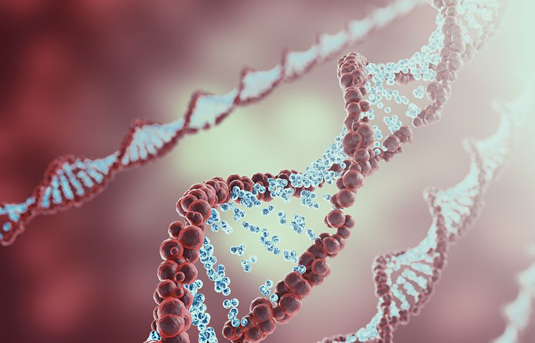Origin of life researchers: Two simple prebiotic hairpin molecules could cooperate

DNA replicating/rost9, fotolia.com
“Prebiotic” chemistry means the development and demonstration of theories about how chemicals washed together and somehow formed the immensely complex structures of life. There is no shortage of single-event scenarios.
A hairpin loop is “an unpaired loop of messenger RNA (mRNA) that is created when an mRNA strand folds and forms base pairs with another section of the same strand. The resulting structure looks like a loop or a U-shape. (Suitable)” In DNA too.
From ScienceDaily:
The evolution of cells and organisms is thought to have been preceded by a phase in which informational molecules like DNA could be replicated selectively. New work shows that hairpin structures make particularly effective DNA replicator.
In the metabolism of all living organisms there is a clear division of labor: Nucleic acids (DNA and RNA) carry the information for the synthesis of proteins, and proteins provide the structural and executive functions required by cells, such as the controlled and specific catalysis of chemical reactions by enzymes. However, in recent decades, it has become clear that this distinction is by no means absolute. In particular RNA is capable of ignoring the boundary outlined above and is known to play a catalytic role in many important processes. For example, certain RNA molecules can catalyze the replication of other nucleic acids, and this versatility could help to explain how life originated on Earth.
…
In subsequent experiments the researchers discovered that two simple hairpin species could cooperate to give rise to a much more efficient replicator, which requires two primers for its amplification. The two hairpin species selected each required a different primer, but their sequences were in part identical. The switch to cooperative replication occurs when replication of one of the hairpins stalls. “As a rule, replication processes in nature are never perfect,” says Dieter Braun. “Such a premature halt is not something that one needs to design into the system. It happens stochastically and we make use of it in our experiments.” The partially replicated hairpin can, however, bind to a molecule of the second species, and serves as a primer that can be further elongated. Moreover, the resulting product no longer forms a hairpin. In other words, it represents a new molecular species. Paper. (paywall) – http://journals.aps.org/prl/abstract/... More.
So, it is simple – like a human language – right? The researchers say it is stochastic (accidental) yet they make it sound like a project. We’ll likely be here a decade from now.
See also: Researchers: Life originated from simple fats, amino acids – but we will likely never know
How ID theorist Michael Behe forced Darwin’s faithful to start talking nonsense
Prebiotic molecules found in proto-suns?
and
What we know and don’t know about the origin of life
Follow UD News at Twitter!
Copyright © 2017 Uncommon Descent . This Feed is for personal non-commercial use only. If you are not reading this material in your news aggregator, the site you are looking at is guilty of copyright infringement UNLESS EXPLICIT PERMISSION OTHERWISE HAS BEEN GIVEN. Please contact legal@uncommondescent.com so we can take legal action immediately.
Plugin by Taragana
Michael J. Behe's Blog
- Michael J. Behe's profile
- 219 followers



